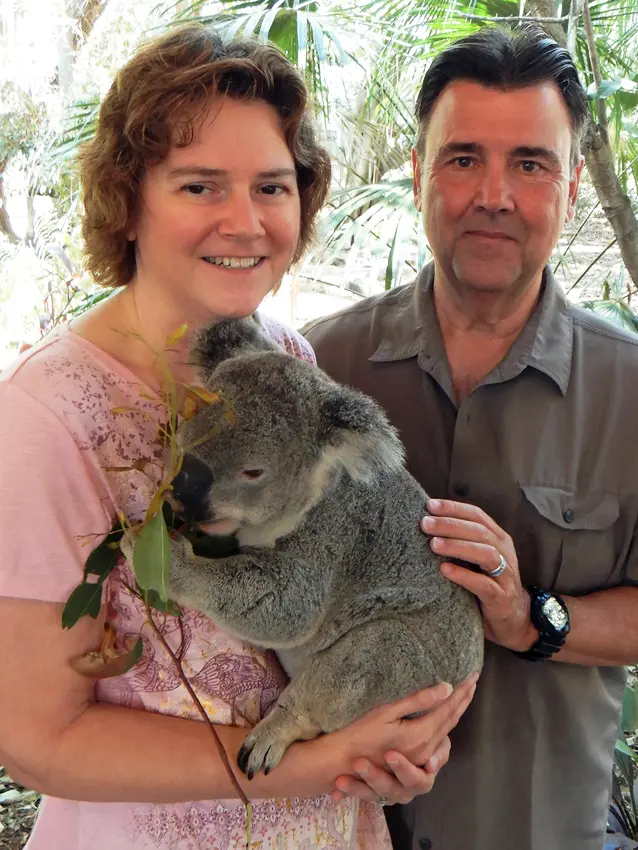Last Updated on September 21, 2020 by PowersToTravel
My research led me to believe that Kyoto would easily be my favorite city in Japan. The results of my study churning around in my mind, I created our list of must-see attractions and quickly became overwhelmed. The temples, markets and castles were spread throughout a large city. I plotted them on a map, measured distances, elevations (oh so important in this city nestled in a bowl of mountains.)
The result is my 4 day awesome itinerary. In retrospect, I don’t think I would have changed a thing, except bring better walking shoes!
Day 1 – Arashiyama merits an entire day
Day 3 – Mt Kuyama, Kinkaku-ji Temple, Nijo Castle
Day 4 – Fushimi Inari Temple, Rengeoin Sanjusangendo, Kizomizu-dera
Day 2 – Ginkaku-ji Temple, The Philosopher’s Path, Honen-in Temple, Anraku-ji Temple, Eikan-do Temple, Nanzen-ji Temple, Pontocho Alley, Nishiki Market
Some context for the itinerary
I chose for our hotel Le Studio Gojo Takakura, a small boutique hotel which I recommend, located just a few blocks from the Gojo metro station; all directions in this article are in reference to the Gojo metro station.
I used this Kyoto Route Planner to identify all of my transport options. You can sort the results by Arrival Time, Travel Time, # of Transfers, Fare and Walking Time. It is a great planner. What is not apparent at first glance is the bus number however if you look at the Japanese characters next to the Bus icon in the results list, you will see one familiar number or set of numbers – that’s the bus number. See the example below:

Also be aware of the bus lines displayed. For example, if you have purchased a Kyoto Bus pass, it will not work on a Keihan bus. In this example, the bus line is “Kyoto City Bus.”
I used Google Maps to plan walking times and elevations. (Did you know that Google Maps will tell you whether a walking route is flat, level or downhill? Just enter the first location, click “Directions”, enter the second location, click the reverse directions icon, and click on the walker icon. Then you can scroll to the bottom of the walking directions in the left panel to see the elevation changes! Make sure you pay attention to the correct starting point and ending point or you may be surprised by the elevation changes! This tool is invaluable in planning a walking / mass transit vacation!)
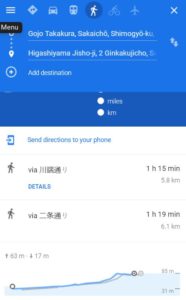
The northeast slopes of the mountains surrounding Kyoto embrace an array of fascinating temples in a surprisingly rural environment. I certainly did not expect such beautiful natural scenery so close to a major city.
Ginkaku-Ji
We took bus #5 from Gojo Takakura to Ginkaku-ji Mishi, about a thirty minute ride. We walked uphill ten minutes or so to the temple. The street was lined with many enticing shops, however since it was early morning, we didn’t stop to snack.
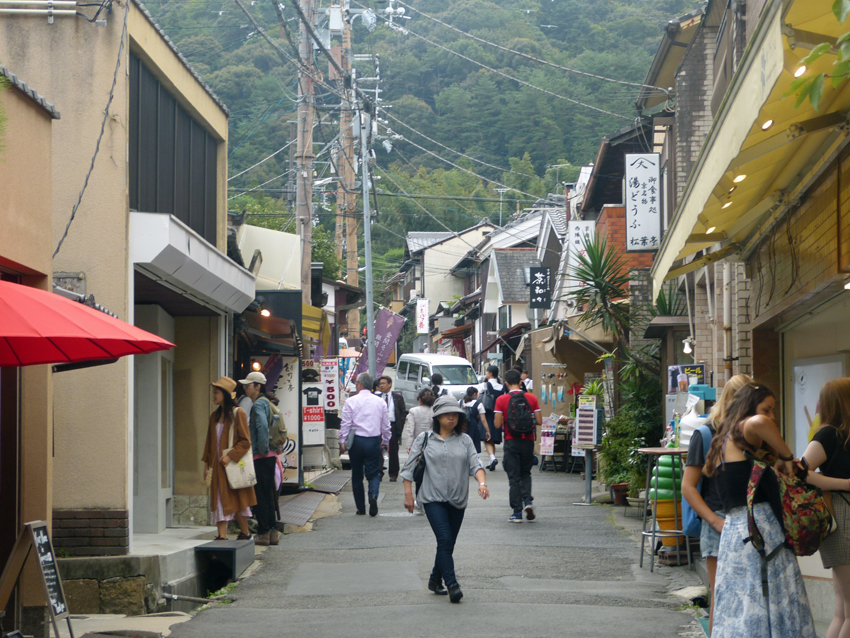
Ginkaku-ji, also known as the “Silver Temple,” is set in a woodsy hollow, complete with pond and zen gardens. We followed the flow of tourists through the gardens and up into the hills above the temple.
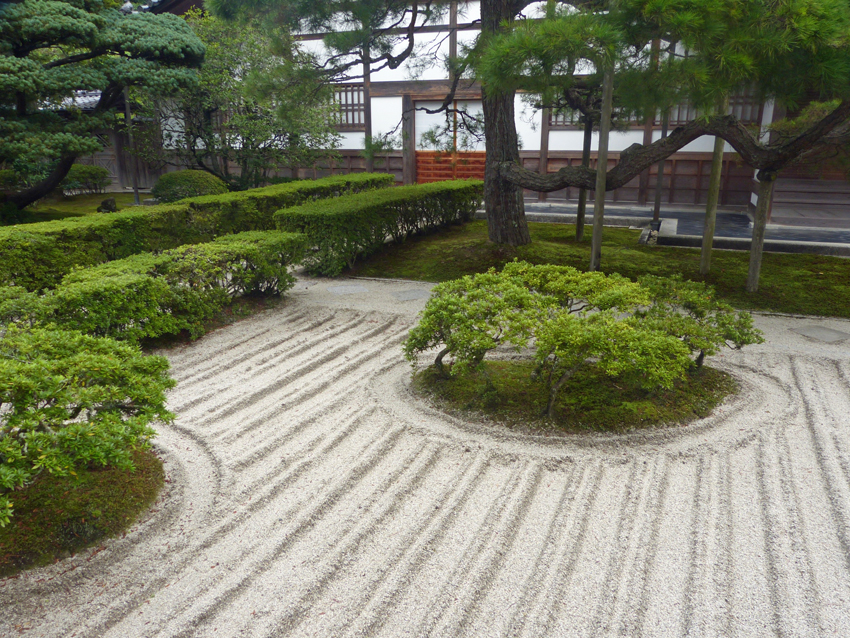
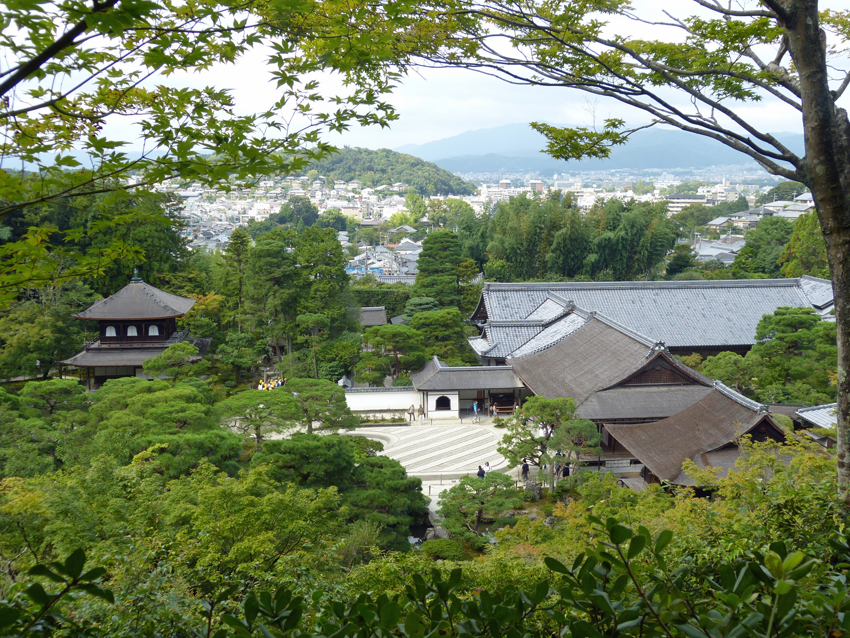
It was at Ginkaku-ji that I realized I would have memory problems here in Japan (at my age?!)
I love to take photographs – they cement the memories in place, as well as go nicely in my blog. However photography is not allowed in many, if not most, Japanese temples. Throughout the trip we would traipse up to the front of the temple, step in, try to memorize what we saw, and then depart, without a single recorded memory. Temple after temple, city after city, and I can only remember the interiors of the ones which allowed interior photography.
In other countries, sometimes they would not permit interior photography either, perhaps in order to encourage the sales of their glossy photo-books. On several occasions in Romania we purchased the small color glossy books – not begrudging them the tourist dollars, or lei, that is, but in Japan they would not allow the photography and had no alternative book to offer us either.
Another frustration at Ginkaku-ji turned out to be the orchestrated tourist path. The skies were overcast. We glanced at the temple buildings, took pictures of the gardens and headed up where everyone else headed, for the views. However, upon our descent we found ourselves immediately shunted out into the street. What???? The sunshine had now come out. I wanted to go back in! I had no idea that the path was a one-way trip out. I wanted to take pictures of the angles of the roof-lines, the trees, the gardens. I would have tried to get back in, but the crowds had gathered by this time, and we decided it was not worth the crush.
Lesson learned – go early! The temple opens at 8:30am. Of course you can’t go early to every attraction, however Ginkaku-ji is a major draw and is situated as the northeastern-most temple on the slopes. It makes an ideal first stop on this excellent walking itinerary – just make it an early stop – don’t sleep in!
Additionally, the best time to photograph Ginkaku-ji is the morning. The view over the temple and to the city from the hill’s walking path faces westerly which means you are not facing into the sun during the morning.
The Philosopher’s Path
We headed a very short distance down the same street we had come up on, and quickly found the well-marked Philosopher’s Path, heading south. The path was a lovely rural/suburban walk over inlaid stones, with a brook to the side, and arching tree branches overhead. Occasionally a bridge linked the path to the temple areas.
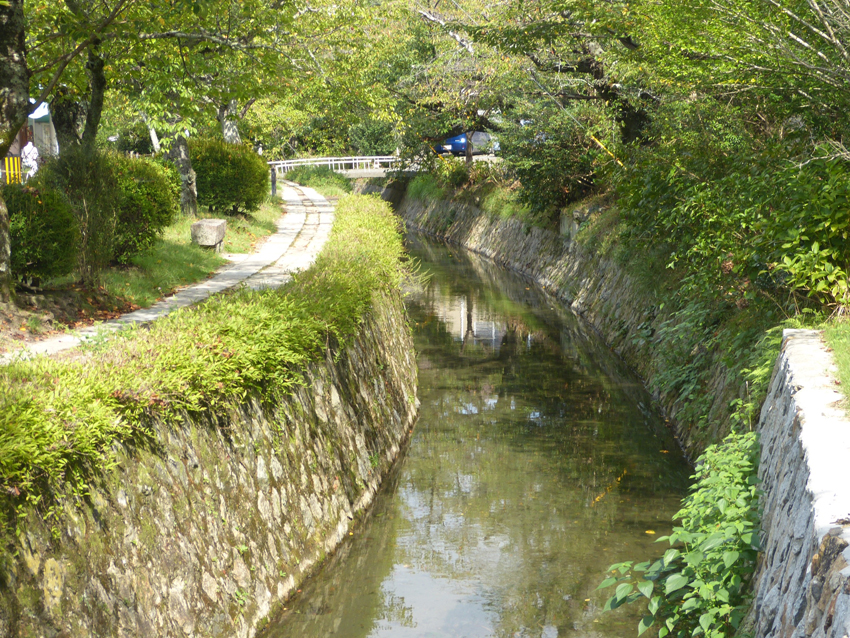
I can easily see how the Path can be a prime destination during fall foliage season. We visited in early October, prior to the foliage season, in a time of slightly less tourist volume.
Honen-in
The next temple south along the Philosopher’s Path is Honen-in, a smaller and more intimate, but nonetheless appealing, temple.
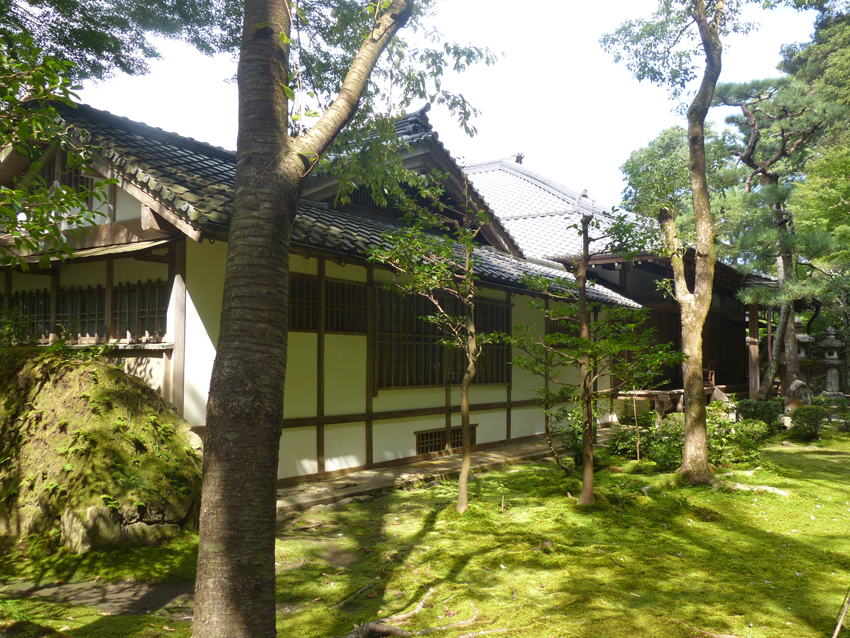
We were not allowed inside the temple at all, so I didn’t experience the same photographer’s frustration as I felt at Ginkaku-ji. A zen garden, a tower, a shrine and a large wooded park complemented the temple.
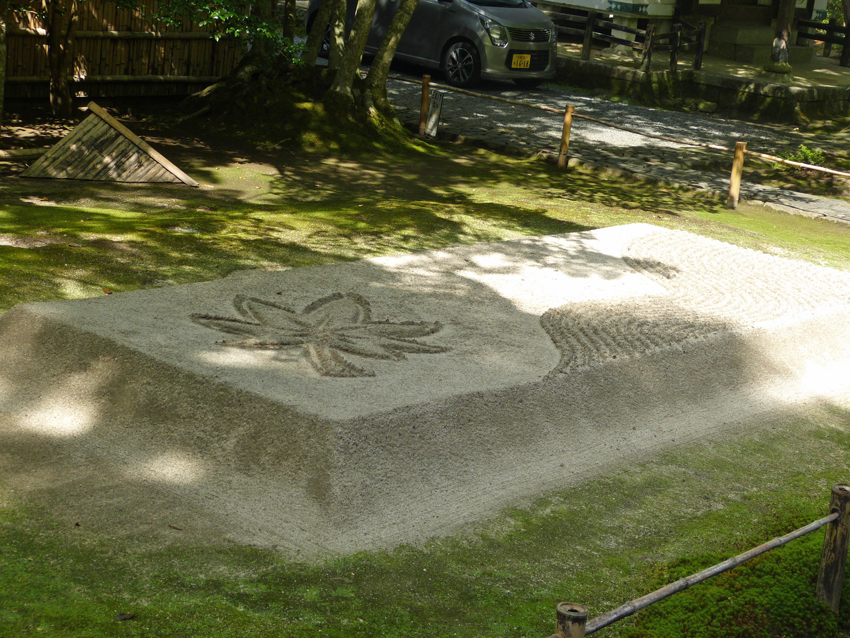
Anraku-ji
We stopped by the small temple Anraku-ji for a quick photo op through the closed gate. I really wished the temple had been open because the glimpse was not enough!
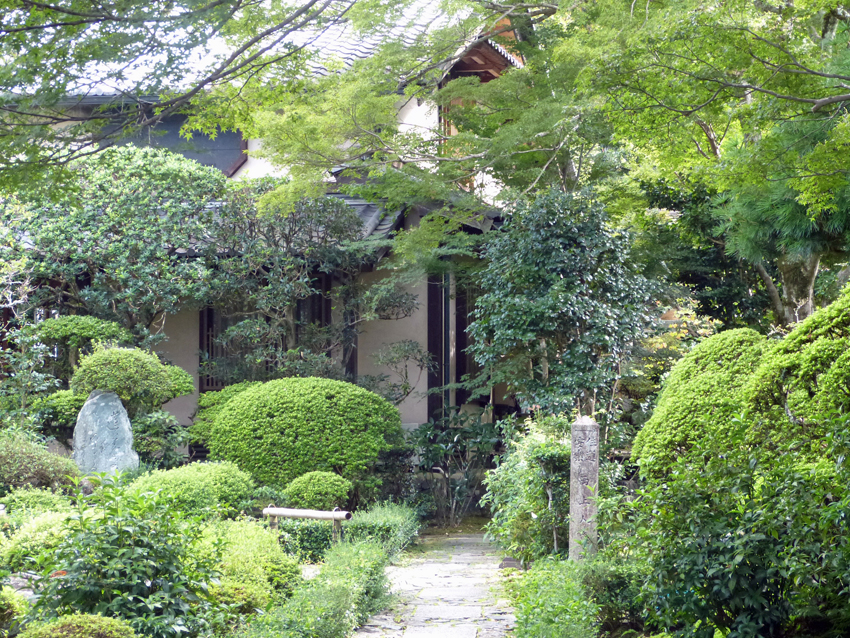
After Anraku-ji, the Philosopher’s Path ended. We found ourselves at the edge of a suburban neighborhood. But it is hard to get lost – we just followed the signs to the temples. We headed downhill, following signs to our next destination, Eikan-do Zenrin-ji.
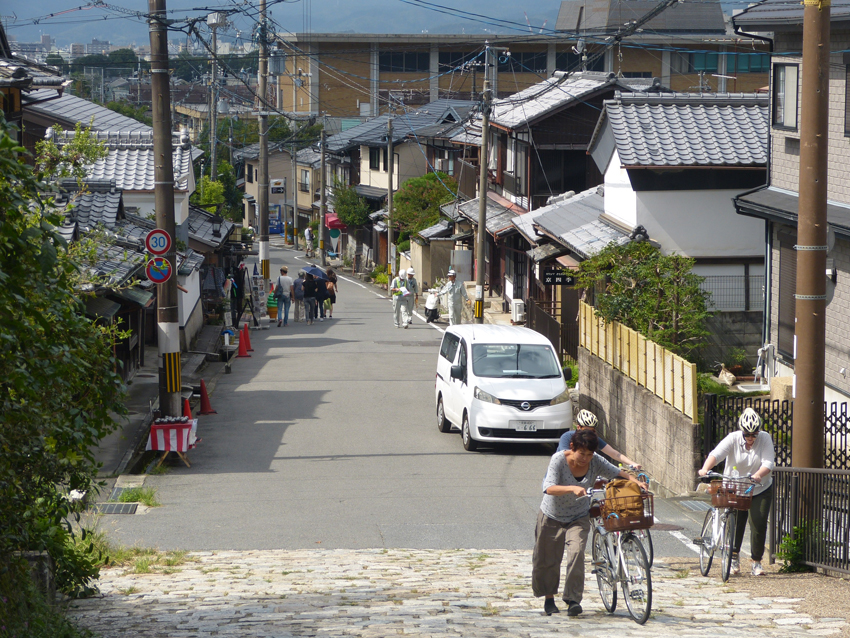
Eikan-do Zenrin-ji
Eikan-do Zenrin-ji receives second tier billing in many Kyoto guides. It is a large enough temple to receive note, but is not given the same attention as Ginkaku-ji. I beg to differ! Eikan-do was my favorite temple in Kyoto!
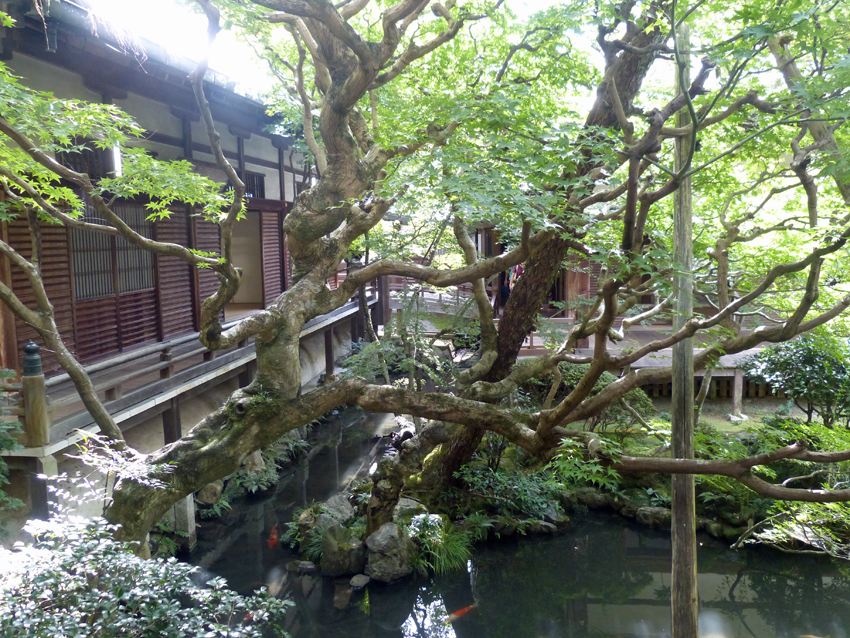
It was a large temple complex, built over many ponds, with awesome gnarled tree branches, as seen above. Light-dappled paths led from temple building to temple building up the slope of the mountain. We passed buildings furnished with the now familiar tatami mats and murals, then at the top found ourselves at a temple with surprisingly beautiful gold interior decoration. We were allowed in, and the benches made a nice break, but photographs again were not allowed. As you can see, Greg took the sign literally, and snuck in a picture from the exterior!
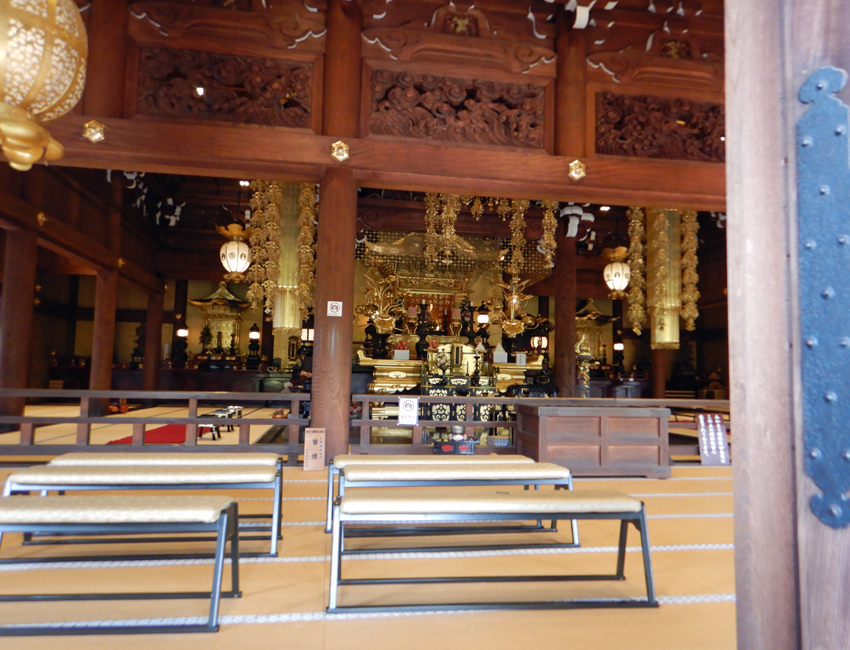
The exterior of this building was remarkable, for two reasons. First, and most appealing to me, was the colorful painting on the trusses. This was the only temple we saw with this type of decoration. Instead of making me feel contemplative and solemn as most of the Japanese temples do, it made me feel happy and excited!
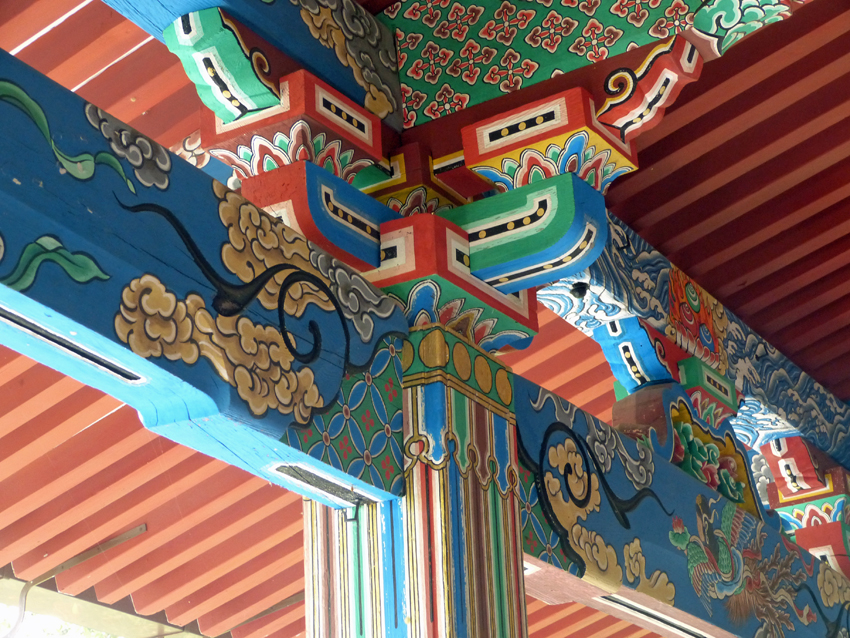
The other interesting feature of this temple was the supposed presence of monkeys. Signs on the door exhorted us to be sure to close the screen doors when entering or leaving the building, as monkeys would invade. We paused here for a little while, hoping to see them, but they evaded us.
Nanzen-ji
Our final temple for the morning was south of Eikan-do, and it is remarkable as well. Large ornate temple buildings stand in imposing positions on high ground, and make for great photography.
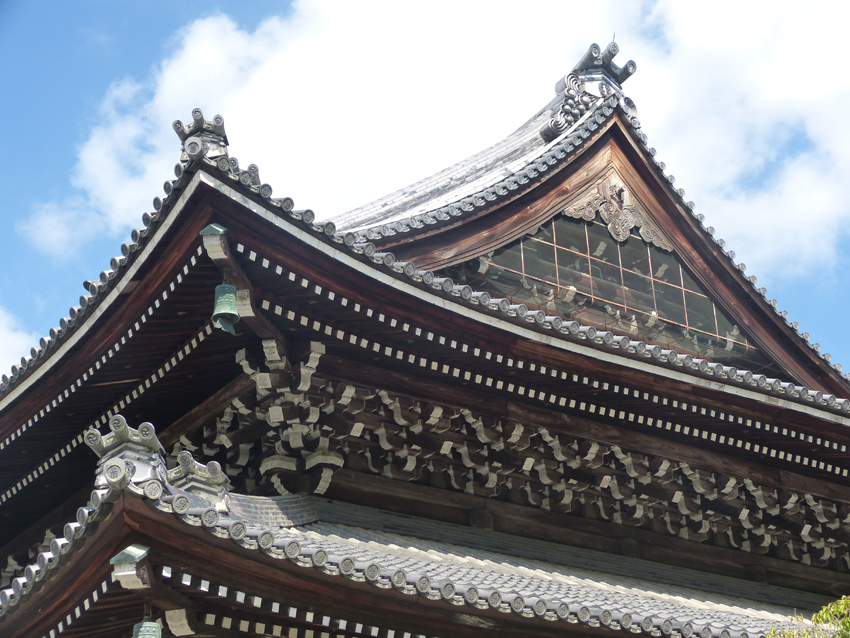
We followed the general flow of people towards the back of the temples, and somewhat uphill. Uphill? We were not too keen on that! But shortly we found the destination, an historic aqueduct, tucked into the wooded hills above the temple.
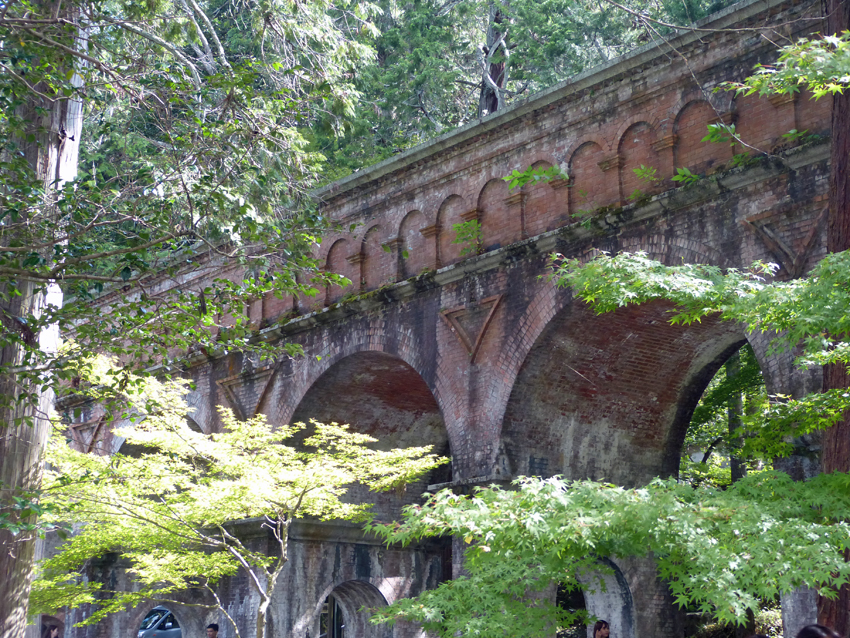
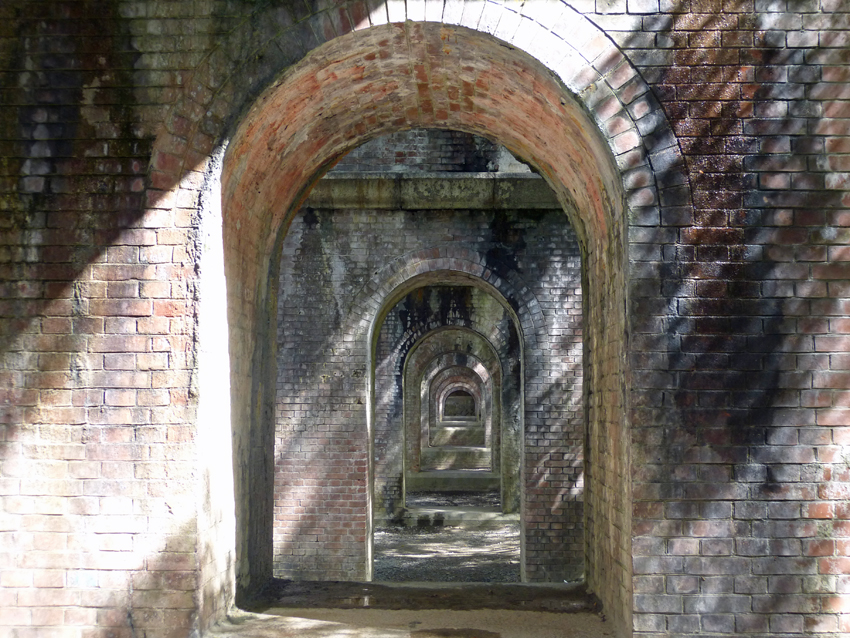
Everyone was climbing stairs and a path up the side of the aqueduct, so we followed. We arrived, panting at the top, expecting that a wonderful temple or view awaited us. No, the path just continued further up the mountain and into the woods.
By this time our legs were really, really tired. We rested a while in the shade, and thought longingly of lunch. Yes! It was time for lunch.
We headed down the streets back into Kyoto, believing we would, around each corner, find a lunch spot. We passed only a couple of restaurants with no guests, and expensive menus. My blood sugar began to fall, and I started to consume my glucose tablets. As my sugars fell, my legs became more and more exhausted. We stumbled down street after street, hoping for food.
Finally we found ourselves in the city, near the river, and wonder-of-all-wonders, found a McDonald’s! It’s not that we love McDonald’s, it’s that McDonald’s guarantees us Diet Cokes, french fries and a sandwich, and quickly.
Pontocho Alley
Such a short distance away from the McDonald’s we located Pontocho Alley, the major dining destination in Kyoto.
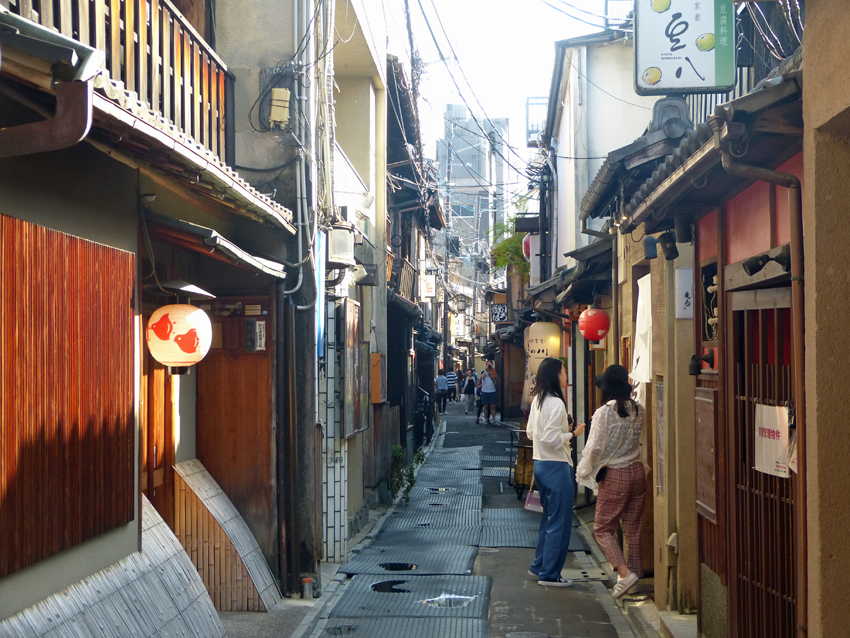
However at 1:30 or so in the afternoon, it was not the hopping place we had imagined it to be. A narrow alley lined with Japanese restaurants of every style, we were so disappointed that we had dove into McDonald’s earlier, however when my blood sugar levels say EAT! and have been saying that for the past hour, and you’ve consumed all your tablets, you don’t mess around.
So I guess I lied – Pontocho Alley is one sight I would have not done in the afternoon on “Day 2.” We should have visited it at dinnertime. (However our legs were too tired then!)
Nishiki Market
We strolled the length of Pontocho Alley and found ourselves not far from Nishiki Market to the west. So, that was where all the people were! The market was a bustling set of side streets, covered with a huge canopy, filled with people, kiosk-style stores selling everything imaginable.
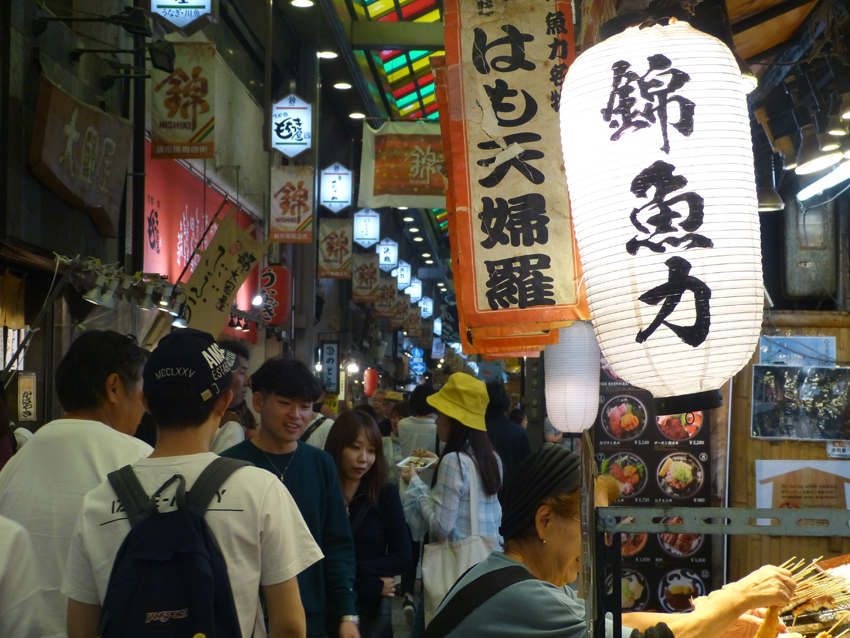
Here Greg decided to try charcoal ice cream. It didn’t appeal to me, although I did try one bite – it was strange in that the ice cream was black, was supposed to contain charcoal, yet tasted just like vanilla ice cream.
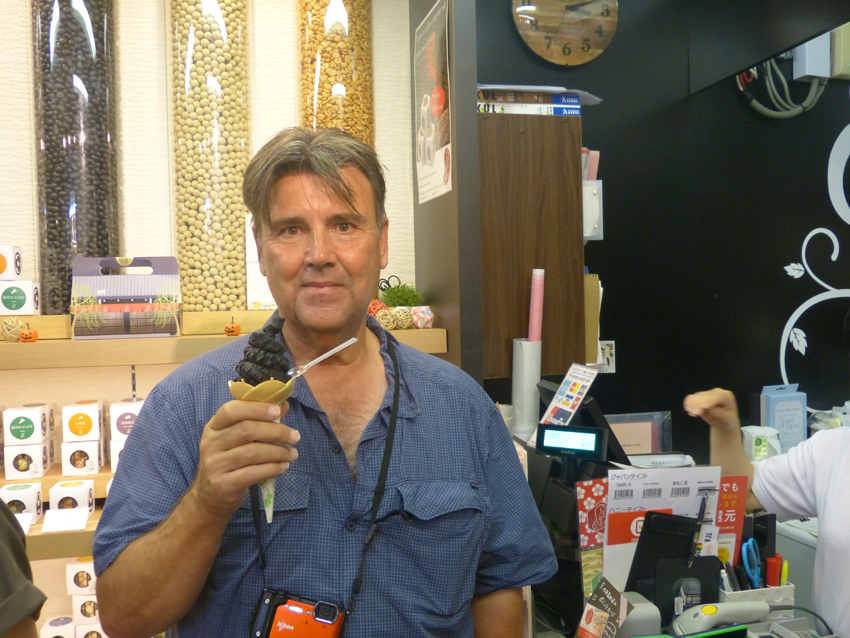
By this point, my feet were killing me! We assessed the situation, and decided that walking directly home would be the quickest way off our feet.
Our hotel was only one km away, down tiny alleys. No need to dodge tourists, no need to wait an unknown time at a bus station, we just headed straight “home.”
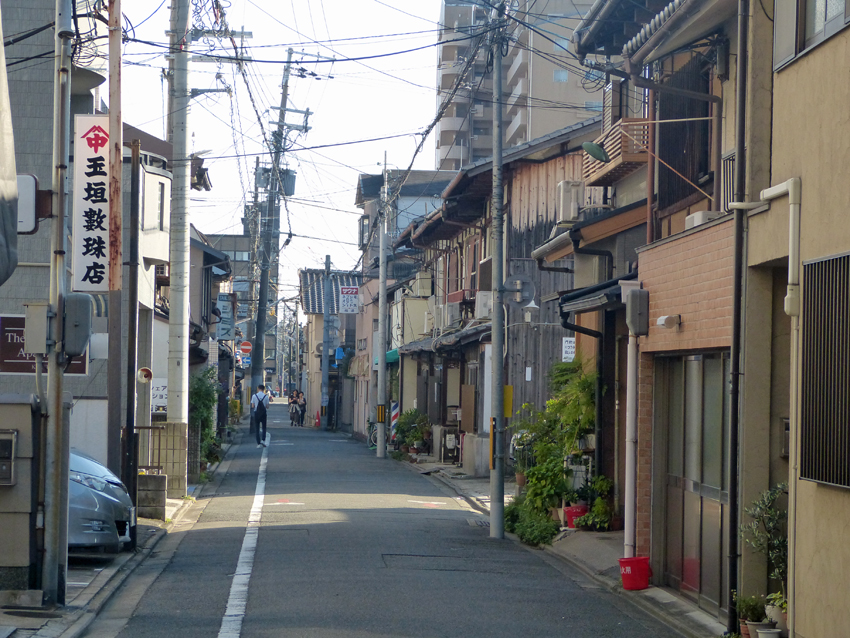
Summary
From the moment we descended from the #5 bus at Ginkaku-ji Michi to our hotel at Takakura-Gojo the walking distance on Google maps totaled 4.8 miles. However, the walking at the temples, going up hills, wandering through gardens, climbing to the top of aqueducts, easily added a mile or so more.

